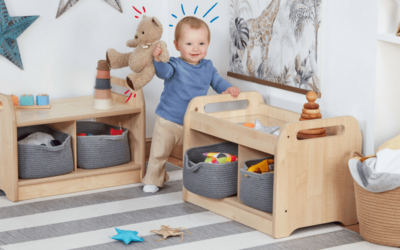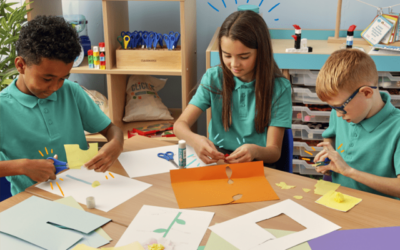6 Top Tips for Developing Mindfulness in the Nursery
Introducing mindfulness and meditation in the nursery can improve children’s wellbeing and mental health, as well as helping them to focus on learning. In celebration of World Meditation Day, we have collated six top tips for introducing mindfulness and meditation to your setting. From guided meditation for kids to increasing mindfulness in the EYFS – we’ve got you covered.
Introduce mindfulness circle times
Mindful meditation in the classroom needn’t eat into your teaching time. Try introducing a short 3-minute circle time session once or twice a day and you will soon find children are more focused, relaxed and ready to learn.
The best time of day for meditative circle time often falls after a period of activity (when the children are full of energy!) First thing in the morning, after playtime or before starting the afternoon’s lessons are all great times to introduce a few calm and contemplative minutes.
You can either choose to use a guided meditation script as the children sit and listen or try a more active form of meditation by asking the children to pretend to blow out candles on a birthday cake (with big inhales of breath) or to gently stroke their own hair/arms etc.
Lead a guided meditation session
Whether you choose to use a mindful circle time or incorporate meditation into your classroom in other ways, it can often be really helpful to lead the children in a guided meditation.
This normally means that the children will lie down quietly with their eyes closed, while you speak softly and lead their mind on a journey. Lying down is a more naturally relaxing position than sitting, but choose whatever works for your space.
Make sure you read any meditation scripts carefully first, so you can tell where it is leading and remember to keep your voice soft and soothing. It can sometimes help to quietly play meditation music in the background.
If you aren’t sure where to start, try this beautiful, guided meditation script written by Mellisa Dormoy from ShambalaKids:
I’m going to tell you a story [today/tonight]. Get comfortable, close your eyes, and imagine that you’re actually inside the story.
Take in a deep breath, and when you let it out, feel everything around you getting calmer and quieter. Take in another long breath, release it slowly, and feel even calmer still.
As you continue to breathe deeply and calmly, notice that the only thing you want to pay attention to is my soothing voice.
Now imagine in front of you, a movie screen. On the screen, you see images from your own life.
You see every time when you did something kind for someone. You also see every time someone did something nice for you.
As you watch the movie, you see how happy you’ve made other people, and you see all the happy times that you’ve had as well.
As you continue to watch this movie, you see a time when you helped somebody who needed you. You see how happy it made them.
Just this thought makes you feel warm and fuzzy inside. Now switch to a time when someone helped you. Think how good you felt to know that someone was there for you.
Feel all those wonderful good feelings come rushing back to your heart! Watch these beautiful moments of your life. Remember how happy you were and how wonderful you felt!
All these happy feelings – all those times you felt warm and fuzzy – were because of a very special feeling: love!
These things you see in front of you happened because you loved and showed that love to someone else, and because they love you.
Love is about taking care of other people, doing nice things, expressing your gratitude and showing kindness and patience. Inside of us, we are all really that – simply LOVE!
That’s really who we are! When we can express this part of ourselves every day, as much as possible… our hearts are filled up with joy and such satisfaction that sometimes we feel we might burst from pure happiness!
And that happy love feeling means that you’re a part of a community of people, a very important part of a very loving universe!
I want you to remember all this love you have inside of you and how easily you can express your love with simply acts of kindness towards yourself and others. You are truly wonderful. You are pure love!
Notice how the love feels like a soft, fuzzy blanket wrapped all around you. It makes you feel warm and peaceful and happy.
Now take in a nice deep breath and exhale slowly. Continue to feel all the wonderful feelings of love and gentleness as you snuggle in for sleep tonight.
Try mindful breathing
If you only have 30 seconds to spare, try a quick mindful breathing exercise to help children relax and refocus. If you are new to mindful breathing exercise, try this one:
- Ask children to sit on a chair with feet flat on the floor (or sit on the floor in a comfortable position).
- Place hands on laps.
- Ask children to close their eyes and slowly breathe in through their nose and out through their mouth (or just through their nose if this is too tricky).
- With each breath, count one beat: breathe in (one), breathe out (two), breathe in (three), breathe out (four) etc. The children do not have to count aloud but can do so in their heads. You can count aloud to help them if needed.
- Continue until you get to ten and then start again.
- Repeat as many times as necessary.
Learn the benefits of meditation
We know that meditation has numerous benefits for adults but it can be transformational for the children in your class too. Research has proven that starting a simple meditation practice with children can:
- Increase self-esteem
- Reduce feelings of worry or stress
- Lead to better sleep
- Improve the ability to focus and concentrate
- Raise wellbeing and improve mental health
Introduce mindful activities into your enhanced provision
Mindful activities do not always have to mean meditation or quiet thought. Mindfulness can also be found in calming, meaningful and repetitive tasks. Try including some of the following ideas into your enhanced provision:
- Colouring sheets
- Pouring water in the water tray
- Watering plants
- Threading or weaving
- Jigsaws
- Blowing bubbles
- Yoga for kids
Try a staff mindful meditation session
Remember all the benefits to meditation and mindful practice we mentioned earlier? They work for adults too! The very best way to get children on board with mindfulness, is following the practise yourself. If you are positive about the benefits, then they will be more eager to try with you.
Why not try introducing a quick mindful meditation session at the start of a weekly staff meeting? Or follow the lead of Waldorf Steiner schools and start each day with whole staff meditation? It may seem new age but it will undoubtedly imbue a sense of calm positivity across the whole school…and who doesn’t want that?
For more expert advice and opinions, take a look at some more articles.
Related blogs
Your Guide to the School-Based Nursery Capital Grant
What is the School-Based Nursery Capital Grant? For schools aiming to enhance their nursery facilities, the School-Based Nursery Capital Grant provides a simple funding solution. This grant is open to eligible state-funded primary schools in England that...
What Goes In, Must Go Out
Creating a Circular Economy in Your Nursery Author: Nick Corlett Sustainability Manager at LEYF Sustainability is more than a trend—it’s a shared responsibility, and the nursery is the perfect place to nurture these skills. Every day...
Top tips to create a SEND-Friendly Primary School Classroom
Author Lindsay Robinson Lindsay Robinson has been a primary school teacher for 23 years and is passionate about achieving the very best outcomes for children through quality first teaching and experiences. I remember receiving very little guidance during my teacher...


